MySQL(多表知识补充) + 分页查询(员工管理)
- 部门管理id int unsigned primary key auto_increment comment 'ID, 主键',name varchar(10) not null unique comment '部门名称',create_time datetime comment '创建时间',update_time datetime comment '修改时间') comment '部门表'
1.多表关系
项目开发中,在进行数据库表结构设计时,会根据业务需求及业务模块之间的关系,分析并设计表结构,由于业务之间相互关联,所以各个表结构之间也存在着各种联系,基本上分为三种:
-
一对多(多对一)
-
多对多
-
一对一
1.1一对多
-
场景:部门与员工的关系(一个部门下有多个员工)。
由于一个部门下,会关联多个员工。 而一个员工,是归属于某一个部门的 。那么此时,我们就需要在 emp 表中增加一个字段 dept_id 来标识这个员工属于哪一个部门,dept_id 关联的是 dept 的 id 。 如下所示:
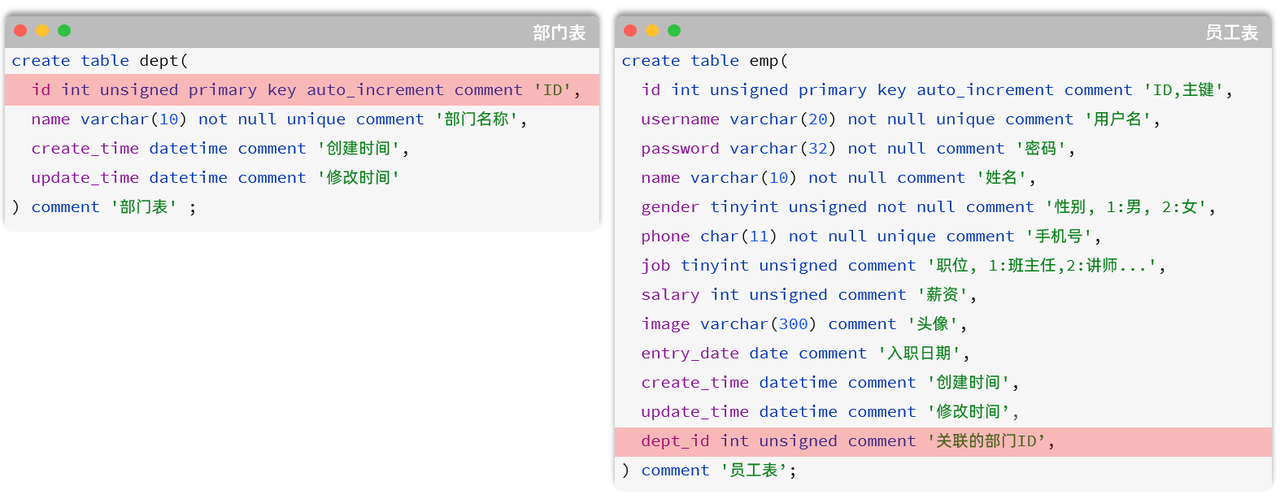
上述的 emp 员工表的 dept_id 字段,关联的是 dept 部门表的 id 。部门表是一的一方,也称为父表,员工表是多的一方,称之为子表。
1.2外键约束
1.2.1引入
-
现象:此时的部门数据可以直接删除,然而还有部分员工归属于该部门下,此时就出现了数据的不完整、不一致问题 。
-
原因:目前上述的两张表,在数据库层面,并未建立关联,所以是无法保证数据的一致性和完整性的 。
-
解决方案:想解决上述的问题呢,我们就可以通过数据库中的 外键约束 来解决。
外键约束:让两张表的数据建立连接,保证数据的一致性和完整性。
对应的关键字:foreign key
语法:
-- 创建表时指定
create table 表名(
字段名 数据类型,
...
[constraint] [外键名称] foreign key (外键字段名) references 主表 (主表列名)
);
-- 建完表后,添加外键
alter table 表名 add constraint 外键名称 foreign key(外键字段名) references 主表(主表列名);sql具体语句:
-- 修改表: 添加外键约束
alter table emp add constraint fk_dept_id foreign key (dept_id) references dept(id);我们还可以通过图形化界面来实现外键约束,此处就不过多赘述。
1.2.2 物理外键与逻辑外键
-
物理外键
-
概念:使用foreign key定义外键关联另外一张表。
-
缺点:
-
影响增、删、改的效率(需要检查外键关系)。
-
仅用于单节点数据库,不适用于分布式、集群场景。
-
容易引发数据库的死锁问题,消耗性能。
-
-
-
逻辑外键
-
概念:在业务层逻辑中,解决外键关联。
-
通过逻辑外键,就可以很方便的解决上述问题。
-
在现在的企业开发中,很少会使用物理外键,都是使用逻辑外键。 甚至在一些数据库开发规范中,会明确指出禁止使用物理外键 foreign key
1.3一对一
如果在业务系统当中,对用户的基本信息查询频率特别的高,但是对于用户的身份信息查询频率很低,此时出于提高查询效率的考虑,我就可以将这张大表拆分成两张小表,第一张表存放的是用户的基本信息,而第二张表存放的就是用户的身份信息。他们两者之间一对一的关系,一个用户只能对应一个身份证,而一个身份证也只能关联一个用户。
那么在数据库层面怎么去体现上述两者之间是一对一的关系呢?
其实一对一我们可以看成一种特殊的一对多。一对多我们是怎么设计表关系的?是不是在多的一方添加外键。同样我们也可以通过外键来体现一对一之间的关系,我们只需要在任意一方来添加一个外键就可以了。

sql脚本:
-- 用户基本信息表
create table tb_user(
id int unsigned primary key auto_increment comment 'ID',
name varchar(10) not null comment '姓名',
gender tinyint unsigned not null comment '性别, 1 男 2 女',
phone char(11) comment '手机号',
degree varchar(10) comment '学历'
) comment '用户基本信息表';
-- 测试数据
insert into tb_user values (1,'白眉鹰王',1,'18812340001','初中'),
(2,'青翼蝠王',1,'18812340002','大专'),
(3,'金毛狮王',1,'18812340003','初中'),
(4,'紫衫龙王',2,'18812340004','硕士');
-- 用户身份信息表
create table tb_user_card(
id int unsigned primary key auto_increment comment 'ID',
nationality varchar(10) not null comment '民族',
birthday date not null comment '生日',
idcard char(18) not null comment '身份证号',
issued varchar(20) not null comment '签发机关',
expire_begin date not null comment '有效期限-开始',
expire_end date comment '有效期限-结束',
user_id int unsigned not null unique comment '用户ID',
constraint fk_user_id foreign key (user_id) references tb_user(id)
) comment '用户身份信息表';
-- 测试数据
insert into tb_user_card values (1,'汉','1960-11-06','100000100000100001','朝阳区公安局','2000-06-10',null,1),
(2,'汉','1971-11-06','100000100000100002','静安区公安局','2005-06-10','2025-06-10',2),
(3,'汉','1963-11-06','100000100000100003','昌平区公安局','2006-06-10',null,3),
(4,'回','1980-11-06','100000100000100004','海淀区公安局','2008-06-10','2028-06-10',4);一对一 :在任意一方加入外键,关联另外一方的主键,并且设置外键为唯一的(UNIQUE)
1.4多对多
多对多的关系在开发中属于也比较常见的。比如:学生和老师的关系,一个学生可以有多个授课老师,一个授课老师也可以有多个学生。在比如:学生和课程的关系,一个学生可以选修多门课程,一个课程也可以供多个学生选修。
案例:学生与课程的关系
-
关系:一个学生可以选修多门课程,一门课程也可以供多个学生选择
-
实现关系:建立第三张中间表,中间表至少包含两个外键,分别关联两方主键

SQL脚本:
-- 学生表
create table tb_student(
id int auto_increment primary key comment '主键ID',
name varchar(10) comment '姓名',
no varchar(10) comment '学号'
) comment '学生表';
-- 学生表测试数据
insert into tb_student(name, no) values ('黛绮丝', '2000100101'),
('谢逊', '2000100102'),
('殷天正', '2000100103'),
('韦一笑', '2000100104');
-- 课程表
create table tb_course(
id int auto_increment primary key comment '主键ID',
name varchar(10) comment '课程名称'
) comment '课程表';
-- 课程表测试数据
insert into tb_course (name) values ('Java'), ('PHP'), ('MySQL') , ('Hadoop');
-- 学生课程表(中间表)
create table tb_student_course(
id int auto_increment comment '主键' primary key,
student_id int not null comment '学生ID',
course_id int not null comment '课程ID',
constraint fk_courseid foreign key (course_id) references tb_course (id),
constraint fk_studentid foreign key (student_id) references tb_student (id)
)comment '学生课程中间表';
-- 学生课程表测试数据
insert into tb_student_course(student_id, course_id) values (1,1),(1,2),(1,3),(2,2),(2,3),(3,4);多对多 :需要建立一张中间表,中间表中有两个外键字段,分别关联两方的主键。
2.多表查询
2.1概述
2.1.1数据准备
-- 部门管理
create table dept(
id int unsigned primary key auto_increment comment 'ID, 主键',
name varchar(10) not null unique comment '部门名称',
create_time datetime comment '创建时间',
update_time datetime comment '修改时间'
) comment '部门表' ;
insert into dept (id, name, create_time, update_time) values
(1,'学工部',now(),now()),
(2,'教研部',now(),now()),
(3,'咨询部',now(),now()),
(4,'就业部',now(),now()),
(5,'人事部',now(),now());
-- 员工管理
create table emp(
id int unsigned primary key auto_increment comment 'ID,主键',
username varchar(20) not null unique comment '用户名',
password varchar(32) not null comment '密码',
name varchar(10) not null comment '姓名',
gender tinyint unsigned not null comment '性别, 1:男, 2:女',
phone char(11) not null unique comment '手机号',
job tinyint unsigned comment '职位, 1:班主任,2:讲师,3:学工主管,4:教研主管,5:咨询师',
salary int unsigned comment '薪资',
image varchar(300) comment '头像',
entry_date date comment '入职日期',
dept_id int unsigned COMMENT '关联的部门ID',
create_time datetime comment '创建时间',
update_time datetime comment '修改时间'
) comment '员工表';
-- 准备测试数据
INSERT INTO `emp` VALUES (1,'shinaian','123456','施耐庵',1,'13309090001',4,15000,'https://dawn-itcast.oss-cn-hangzhou.aliyuncs.com/01.png','2000-01-01',2,'2023-10-27 16:35:33','2023-10-27 16:35:35'),
(2,'songjiang','123456','宋江',1,'13309090002',2,8600,'https://dawn-itcast.oss-cn-hangzhou.aliyuncs.com/01.png','2015-01-01',2,'2023-10-27 16:35:33','2023-10-27 16:35:37'),
(3,'lujunyi','123456','卢俊义',1,'13309090003',2,8900,'https://dawn-itcast.oss-cn-hangzhou.aliyuncs.com/01.png','2008-05-01',2,'2023-10-27 16:35:33','2023-10-27 16:35:39'),
(4,'wuyong','123456','吴用',1,'13309090004',2,9200,'https://dawn-itcast.oss-cn-hangzhou.aliyuncs.com/01.png','2007-01-01',2,'2023-10-27 16:35:33','2023-10-27 16:35:41'),
(5,'gongsunsheng','123456','公孙胜',1,'13309090005',2,9500,'https://dawn-itcast.oss-cn-hangzhou.aliyuncs.com/01.png','2012-12-05',2,'2023-10-27 16:35:33','2023-10-27 16:35:43'),
(6,'huosanniang','123456','扈三娘',2,'13309090006',3,6500,'https://dawn-itcast.oss-cn-hangzhou.aliyuncs.com/01.png','2013-09-05',1,'2023-10-27 16:35:33','2023-10-27 16:35:45'),
(7,'chaijin','123456','柴进',1,'13309090007',1,4700,'https://dawn-itcast.oss-cn-hangzhou.aliyuncs.com/01.png','2005-08-01',1,'2023-10-27 16:35:33','2023-10-27 16:35:47'),
(8,'likui','123456','李逵',1,'13309090008',1,4800,'https://dawn-itcast.oss-cn-hangzhou.aliyuncs.com/01.png','2014-11-09',1,'2023-10-27 16:35:33','2023-10-27 16:35:49'),
(9,'wusong','123456','武松',1,'13309090009',1,4900,'https://dawn-itcast.oss-cn-hangzhou.aliyuncs.com/01.png','2011-03-11',1,'2023-10-27 16:35:33','2023-10-27 16:35:51'),
(10,'lichong','123456','林冲',1,'13309090010',1,5000,'https://dawn-itcast.oss-cn-hangzhou.aliyuncs.com/01.png','2013-09-05',1,'2023-10-27 16:35:33','2023-10-27 16:35:53'),
(11,'huyanzhuo','123456','呼延灼',1,'13309090011',2,9700,'https://dawn-itcast.oss-cn-hangzhou.aliyuncs.com/01.png','2007-02-01',2,'2023-10-27 16:35:33','2023-10-27 16:35:55'),
(12,'xiaoliguang','123456','小李广',1,'13309090012',2,10000,'https://dawn-itcast.oss-cn-hangzhou.aliyuncs.com/01.png','2008-08-18',2,'2023-10-27 16:35:33','2023-10-27 16:35:57'),
(13,'yangzhi','123456','杨志',1,'13309090013',1,5300,'https://dawn-itcast.oss-cn-hangzhou.aliyuncs.com/01.png','2012-11-01',1,'2023-10-27 16:35:33','2023-10-27 16:35:59'),
(14,'shijin','123456','史进',1,'13309090014',2,10600,'https://dawn-itcast.oss-cn-hangzhou.aliyuncs.com/01.png','2002-08-01',2,'2023-10-27 16:35:33','2023-10-27 16:36:01'),
(15,'sunerniang','123456','孙二娘',2,'13309090015',2,10900,'https://dawn-itcast.oss-cn-hangzhou.aliyuncs.com/01.png','2011-05-01',2,'2023-10-27 16:35:33','2023-10-27 16:36:03'),
(16,'luzhishen','123456','鲁智深',1,'13309090016',2,9600,'https://dawn-itcast.oss-cn-hangzhou.aliyuncs.com/01.png','2010-01-01',2,'2023-10-27 16:35:33','2023-10-27 16:36:05'),
(17,'liying','12345678','李应',1,'13309090017',1,5800,'https://dawn-itcast.oss-cn-hangzhou.aliyuncs.com/01.png','2015-03-21',1,'2023-10-27 16:35:33','2023-10-27 16:36:07'),
(18,'shiqian','123456','时迁',1,'13309090018',2,10200,'https://dawn-itcast.oss-cn-hangzhou.aliyuncs.com/01.png','2015-01-01',2,'2023-10-27 16:35:33','2023-10-27 16:36:09'),
(19,'gudasao','123456','顾大嫂',2,'13309090019',2,10500,'https://dawn-itcast.oss-cn-hangzhou.aliyuncs.com/01.png','2008-01-01',2,'2023-10-27 16:35:33','2023-10-27 16:36:11'),
(20,'ruanxiaoer','123456','阮小二',1,'13309090020',2,10800,'https://dawn-itcast.oss-cn-hangzhou.aliyuncs.com/01.png','2018-01-01',2,'2023-10-27 16:35:33','2023-10-27 16:36:13'),
(21,'ruanxiaowu','123456','阮小五',1,'13309090021',5,5200,'https://dawn-itcast.oss-cn-hangzhou.aliyuncs.com/01.png','2015-01-01',3,'2023-10-27 16:35:33','2023-10-27 16:36:15'),
(22,'ruanxiaoqi','123456','阮小七',1,'13309090022',5,5500,'https://dawn-itcast.oss-cn-hangzhou.aliyuncs.com/01.png','2016-01-01',3,'2023-10-27 16:35:33','2023-10-27 16:36:17'),
(23,'ruanji','123456','阮籍',1,'13309090023',5,5800,'https://dawn-itcast.oss-cn-hangzhou.aliyuncs.com/01.png','2012-01-01',3,'2023-10-27 16:35:33','2023-10-27 16:36:19'),
(24,'tongwei','123456','童威',1,'13309090024',5,5000,'https://dawn-itcast.oss-cn-hangzhou.aliyuncs.com/01.png','2006-01-01',3,'2023-10-27 16:35:33','2023-10-27 16:36:21'),
(25,'tongmeng','123456','童猛',1,'13309090025',5,4800,'https://dawn-itcast.oss-cn-hangzhou.aliyuncs.com/01.png','2002-01-01',3,'2023-10-27 16:35:33','2023-10-27 16:36:23'),
(26,'yanshun','123456','燕顺',1,'13309090026',5,5400,'https://dawn-itcast.oss-cn-hangzhou.aliyuncs.com/01.png','2011-01-01',3,'2023-10-27 16:35:33','2023-10-27 16:36:25'),
(27,'lijun','123456','李俊',1,'13309090027',5,6600,'https://dawn-itcast.oss-cn-hangzhou.aliyuncs.com/01.png','2004-01-01',3,'2023-10-27 16:35:33','2023-10-27 16:36:27'),
(28,'lizhong','123456','李忠',1,'13309090028',5,5000,'https://dawn-itcast.oss-cn-hangzhou.aliyuncs.com/01.png','2007-01-01',3,'2023-10-27 16:35:33','2023-10-27 16:36:29'),
(29,'songqing','123456','宋清',1,'13309090029',NULL,5100,'https://dawn-itcast.oss-cn-hangzhou.aliyuncs.com/01.png','2020-01-01',NULL,'2023-10-27 16:35:33','2023-10-27 16:36:31'),
(30,'liyun','123456','李云',1,'13309090030',NULL,NULL,'https://dawn-itcast.oss-cn-hangzhou.aliyuncs.com/01.png','2020-03-01',NULL,'2023-10-27 16:35:33','2023-10-27 16:36:31');
2.2.2介绍
多表查询:查询时从多张表中获取所需数据
查询用户表和部门表中的数据:
select * from emp , dept;
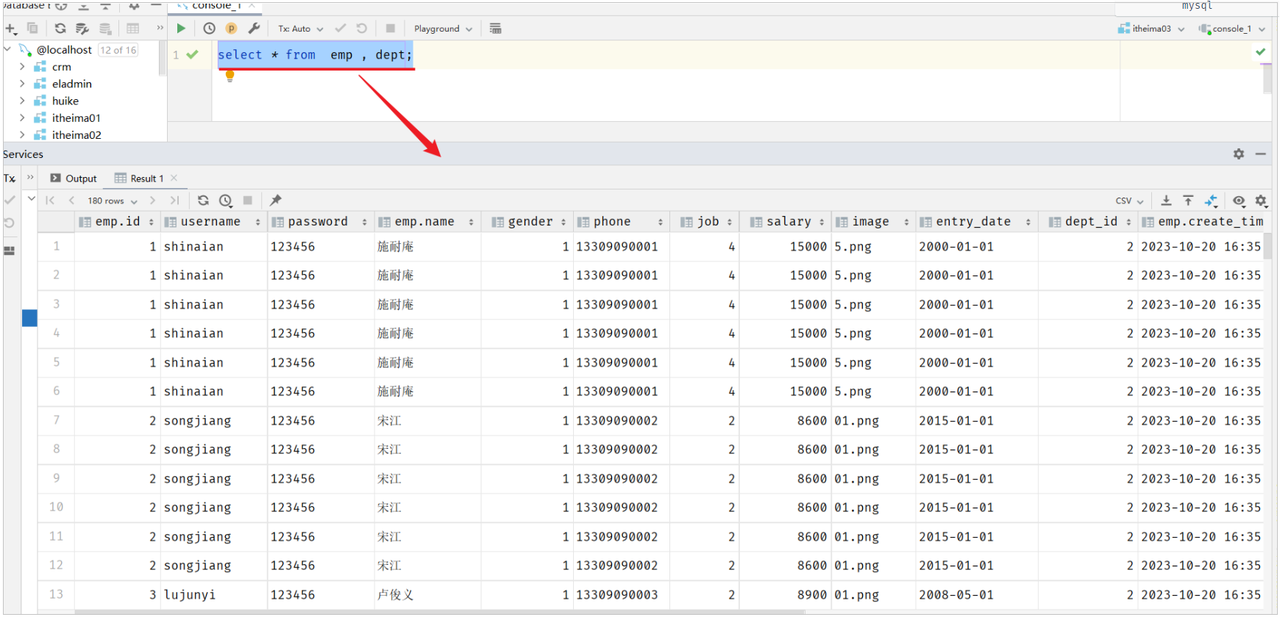
此时,我们看到查询结果中包含了大量的结果集,总共180条记录,而这其实就是员工表所有的记录(30行)与部门表所有记录(6行)的所有组合情况,这种现象称之为笛卡尔积。
笛卡尔积:笛卡尔乘积是指在数学中,两个集合(A集合和B集合)的所有组合情况。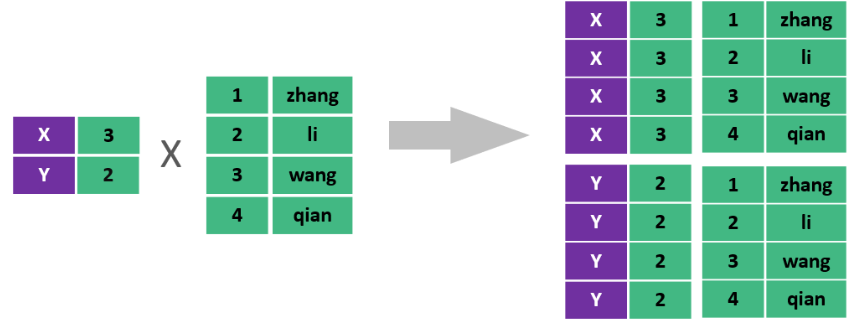
在多表查询时,需要消除无效的笛卡尔积,只保留表关联部分的数据
只需要给多表查询加上连接查询的条件即可。
select * from emp , dept where emp.dept_id = dept.id ;2.1.3分类
多表查询可以分为:
1.连接查询
(1)内连接:相当于查询A、B交集部分数据
(2)外连接
①左外连接:查询左表所有数据(包括两张表交集部分数据)
②右外连接:查询右表所有数据(包括两张表交集部分数据)
2.子查询
2.2内连接
内连接查询:查询两表或多表中交集部分数据。
内连接从语法上可以分为:
-
隐式内连接
-
显式内连接
隐式内连接语法:
select 字段列表 from 表1 , 表2 where 条件 ... ;显式内连接语法:
select 字段列表 from 表1 [ inner ] join 表2 on 连接条件 ... ;-
案例:查询所有员工的ID,姓名,及所属的部门名称
-
隐式内连接实现
select emp.id, emp.name, dept.name from emp , dept where emp.dept_id = dept.id;-
显式内连接实现
select emp.id, emp.name, dept.name from emp inner join dept on emp.dept_id = dept.id;在多表联查时,我们指定字段时,需要在字段名前面加上表名,来指定具体是哪一张的字段。 如:emp.dept_id
给表起别名简化书写:
select 字段列表 from 表1 as 别名1 , 表2 as 别名2 where 条件 ... ;
select 字段列表 from 表1 别名1 , 表2 别名2 where 条件 ... ; -- as 可以省略注意事项: 一旦为表起了别名,就不能再使用表名来指定对应的字段了,此时只能够使用别名来指定字段。
2.3外连接
外连接分为两种:左外连接 和 右外连接。
左外连接语法:
select 字段列表 from 表1 left [ outer ] join 表2 on 连接条件 ... ;左外连接相当于查询表1(左表)的所有数据,当然也包含表1和表2交集部分的数据。
右外连接语法:
select 字段列表 from 表1 right [ outer ] join 表2 on 连接条件 ... ;右外连接相当于查询表2(右表)的所有数据,当然也包含表1和表2交集部分的数据。
案例1:查询员工表 所有 员工的姓名, 和对应的部门名称 (左外连接)
-- 左外连接:以left join关键字左边的表为主表,查询主表中所有数据,以及和主表匹配的右边表中的数据
select e.name , d.name from emp as e left join dept as d on e.dept_id = d.id ;2.4子查询
介绍
SQL语句中嵌套select语句,称为嵌套查询,又称子查询。
SELECT * FROM t1 WHERE column1 = ( SELECT column1 FROM t2 ... );子查询外部的语句可以是insert / update / delete / select 的任何一个,最常见的是 select。
根据子查询结果的不同分为:
-
标量子查询(子查询结果为单个值 [一行一列])
-
列子查询(子查询结果为一列,但可以是多行)
-
行子查询(子查询结果为一行,但可以是多列)
-
表子查询(子查询结果为多行多列[相当于子查询结果是一张表])
子查询可以书写的位置:
-
where之后
-
from之后
-
select之后
子查询的要点是,先对需求做拆分,明确具体的步骤,然后再逐条编写SQL语句。 最终将多条SQL语句合并为一条。
标量查询
子查询返回的结果是单个值(数字、字符串、日期等),最简单的形式,这种子查询称为标量子查询。
常用的操作符: = <> > >= < <=
-
案例1:查询 最早入职 的员工信息
-- 1. 查询最早的入职时间
select min(entry_date) from emp; -- 结果: 2000-01-01
-- 2. 查询入职时间 = 最早入职时间的员工信息
select * from emp where entry_date = '2000-01-01';
-- 3. 合并为一条SQL
select * from emp where entry_date = (select min(entry_date) from emp);列子查询
子查询返回的结果是一列(可以是多行),这种子查询称为列子查询。
常用的操作符:
| 操作符 | 描述 |
| in | 在指定的集合范围之内,多选一 |
| not in | 不在指定的集合范围之内 |
-
案例1:查询 "教研部" 和 "咨询部" 的所有员工信息
-- 1. 查询 "教研部" 和 "咨询部" 的部门ID
select id from dept where name = '教研部' or name = '咨询部'; -- 结果: 3,2
-- 2. 根据上面查询出来的部门ID, 查询员工信息
select * from emp where dept_id in(3,2);
-- 3. 合并SQL为一条SQL语句
select * from emp where dept_id in (select id from dept where name = '教研部' or name = '咨询部');行子查询
子查询返回的结果是一行(可以是多列),这种子查询称为行子查询。
常用的操作符:= 、<> 、IN 、NOT IN
-
案例1:查询与 "李忠" 的薪资 及 职位都相同的员工信息
-- 1. 查询 "李忠" 的薪资和职位
select salary , job from emp where name = '李忠'; -- 结果: 5000, 5
-- 2. 根据上述查询到的薪资和职位 , 查询对应员工的信息
select * from emp where (salary, job) = (5000,5);
-- 3. 将两条SQL合并为一条SQL
select * from emp where (salary, job) = (select salary , job from emp where name = '李忠');表子查询
子查询返回的结果是多行多列,常作为临时表,这种子查询称为表子查询。
-
案例:获取每个部门中薪资最高的员工信息
-- a. 获取每个部门的最高薪资
select dept_id, max(salary) from emp group by dept_id;
-- b. 查询每个部门中薪资最高的员工信息
select * from emp e , (select dept_id, max(salary) max_sal from emp group by dept_id) a
where e.dept_id = a.dept_id and e.salary = a.max_sal;3.员工列表查询
那接下来,我们要来完成的是员工列表的查询功能实现。 具体的需求如下:
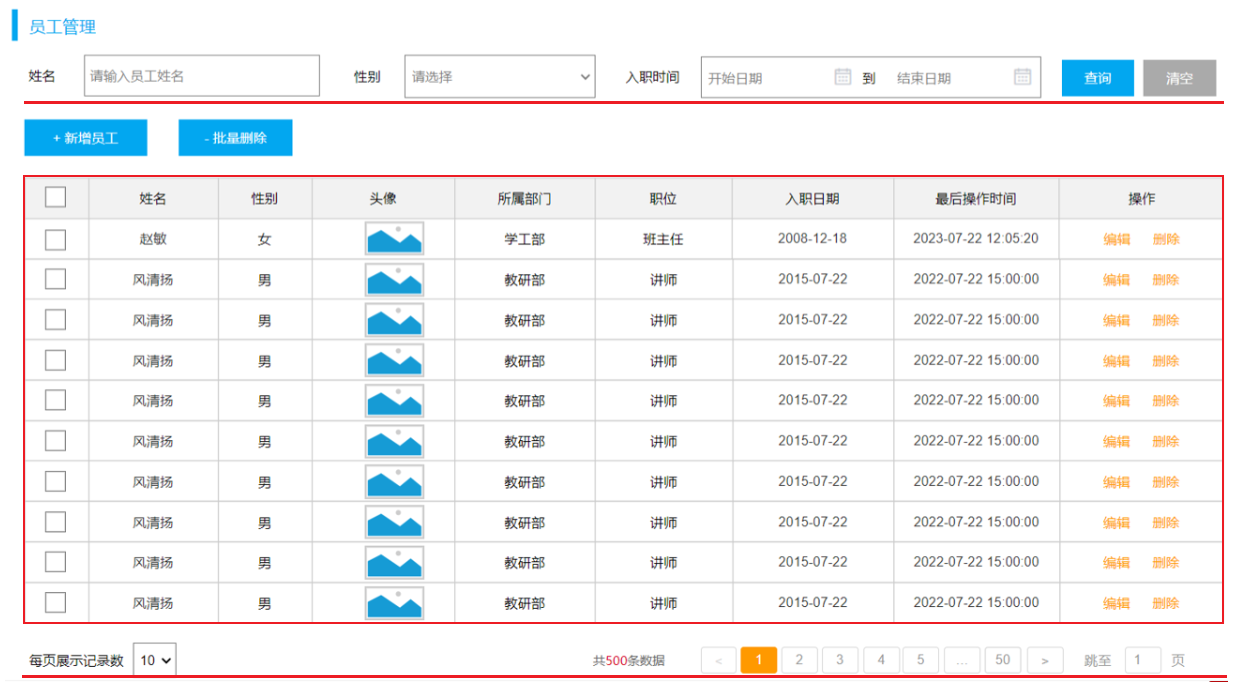 在查询员工列表数据时,既需要查询 员工的基本信息,还需要查询员工所属的部门名称,所以这里呢,会涉及到多表查询的操作。
在查询员工列表数据时,既需要查询 员工的基本信息,还需要查询员工所属的部门名称,所以这里呢,会涉及到多表查询的操作。
而且,在查询员工列表数据时,既要考虑搜索栏中的查询条件,还要考虑对查询的结果进行分页处理。
那么接下来,我们在实现这个功能时,将会分为三个部分来逐一实现:
-
准备工作
-
分页查询
-
条件分页查询
3.1准备工作
需求:查询所有员工信息,并查询出部门名称。(涉及到的表:emp、dept)
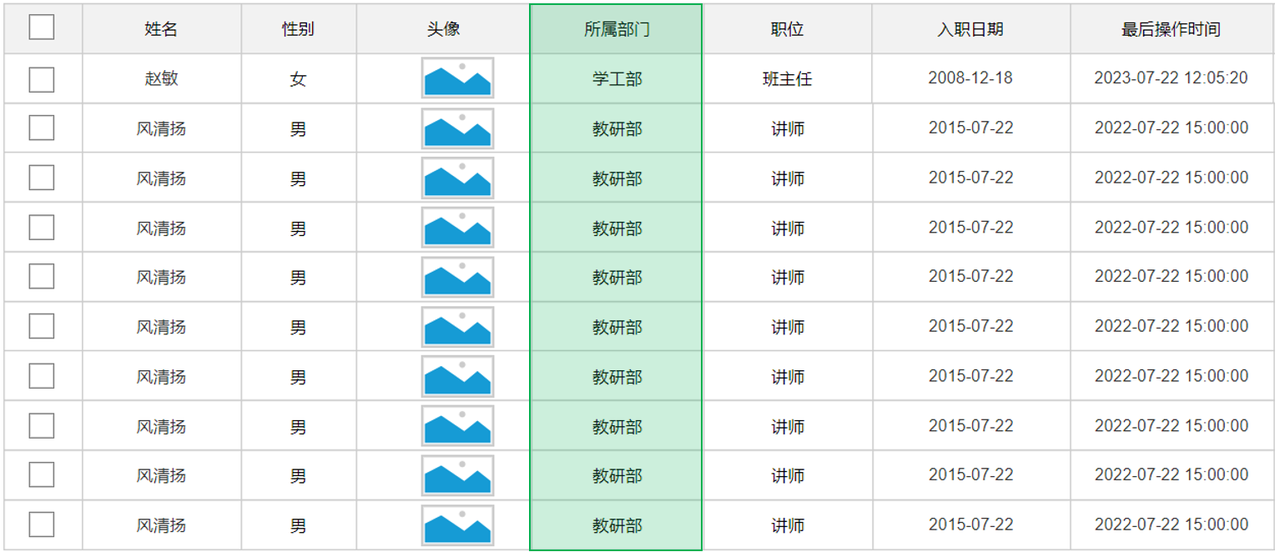
1). 创建员工管理相关表结构
-- 员工表
create table emp(
id int unsigned primary key auto_increment comment 'ID,主键',
username varchar(20) not null unique comment '用户名',
password varchar(50) default '123456' comment '密码',
name varchar(10) not null comment '姓名',
gender tinyint unsigned not null comment '性别, 1:男, 2:女',
phone char(11) not null unique comment '手机号',
job tinyint unsigned comment '职位, 1 班主任, 2 讲师 , 3 学工主管, 4 教研主管, 5 咨询师',
salary int unsigned comment '薪资',
image varchar(300) comment '头像',
entry_date date comment '入职日期',
dept_id int unsigned comment '部门ID',
create_time datetime comment '创建时间',
update_time datetime comment '修改时间'
) comment '员工表';
INSERT INTO emp VALUES
(1,'shinaian','123456','施耐庵',1,'13309090001',4,15000,'https://web-framework.oss-cn-hangzhou.aliyuncs.com/2023/1.jpg','2000-01-01',2,'2023-10-20 16:35:33','2023-11-16 16:11:26'),
(2,'songjiang','123456','宋江',1,'13309090002',2,8600,'https://web-framework.oss-cn-hangzhou.aliyuncs.com/2023/1.jpg','2015-01-01',2,'2023-10-20 16:35:33','2023-10-20 16:35:37'),
(3,'lujunyi','123456','卢俊义',1,'13309090003',2,8900,'https://web-framework.oss-cn-hangzhou.aliyuncs.com/2023/1.jpg','2008-05-01',2,'2023-10-20 16:35:33','2023-10-20 16:35:39'),
(4,'wuyong','123456','吴用',1,'13309090004',2,9200,'https://web-framework.oss-cn-hangzhou.aliyuncs.com/2023/1.jpg','2007-01-01',2,'2023-10-20 16:35:33','2023-10-20 16:35:41'),
(5,'gongsunsheng','123456','公孙胜',1,'13309090005',2,9500,'https://web-framework.oss-cn-hangzhou.aliyuncs.com/2023/1.jpg','2012-12-05',2,'2023-10-20 16:35:33','2023-10-20 16:35:43'),
(6,'huosanniang','123456','扈三娘',2,'13309090006',3,6500,'https://web-framework.oss-cn-hangzhou.aliyuncs.com/2023/1.jpg','2013-09-05',1,'2023-10-20 16:35:33','2023-10-20 16:35:45'),
(7,'chaijin','123456','柴进',1,'13309090007',1,4700,'https://web-framework.oss-cn-hangzhou.aliyuncs.com/2023/1.jpg','2005-08-01',1,'2023-10-20 16:35:33','2023-10-20 16:35:47'),
(8,'likui','123456','李逵',1,'13309090008',1,4800,'https://web-framework.oss-cn-hangzhou.aliyuncs.com/2023/1.jpg','2014-11-09',1,'2023-10-20 16:35:33','2023-10-20 16:35:49'),
(9,'wusong','123456','武松',1,'13309090009',1,4900,'https://web-framework.oss-cn-hangzhou.aliyuncs.com/2023/1.jpg','2011-03-11',1,'2023-10-20 16:35:33','2023-10-20 16:35:51'),
(10,'linchong','123456','林冲',1,'13309090010',1,5000,'https://web-framework.oss-cn-hangzhou.aliyuncs.com/2023/1.jpg','2013-09-05',1,'2023-10-20 16:35:33','2023-10-20 16:35:53'),
(11,'huyanzhuo','123456','呼延灼',1,'13309090011',2,9700,'https://web-framework.oss-cn-hangzhou.aliyuncs.com/2023/1.jpg','2007-02-01',2,'2023-10-20 16:35:33','2023-10-20 16:35:55'),
(12,'xiaoliguang','123456','小李广',1,'13309090012',2,10000,'https://web-framework.oss-cn-hangzhou.aliyuncs.com/2023/1.jpg','2008-08-18',2,'2023-10-20 16:35:33','2023-10-20 16:35:57'),
(13,'yangzhi','123456','杨志',1,'13309090013',1,5300,'https://web-framework.oss-cn-hangzhou.aliyuncs.com/2023/1.jpg','2012-11-01',1,'2023-10-20 16:35:33','2023-10-20 16:35:59'),
(14,'shijin','123456','史进',1,'13309090014',2,10600,'https://web-framework.oss-cn-hangzhou.aliyuncs.com/2023/1.jpg','2002-08-01',2,'2023-10-20 16:35:33','2023-10-20 16:36:01'),
(15,'sunerniang','123456','孙二娘',2,'13309090015',2,10900,'https://web-framework.oss-cn-hangzhou.aliyuncs.com/2023/1.jpg','2011-05-01',2,'2023-10-20 16:35:33','2023-10-20 16:36:03'),
(16,'luzhishen','123456','鲁智深',1,'13309090016',2,9600,'https://web-framework.oss-cn-hangzhou.aliyuncs.com/2023/1.jpg','2010-01-01',2,'2023-10-20 16:35:33','2023-10-20 16:36:05'),
(17,'liying','12345678','李应',1,'13309090017',1,5800,'https://web-framework.oss-cn-hangzhou.aliyuncs.com/2023/1.jpg','2015-03-21',1,'2023-10-20 16:35:33','2023-10-20 16:36:07'),
(18,'shiqian','123456','时迁',1,'13309090018',2,10200,'https://web-framework.oss-cn-hangzhou.aliyuncs.com/2023/1.jpg','2015-01-01',2,'2023-10-20 16:35:33','2023-10-20 16:36:09'),
(19,'gudasao','123456','顾大嫂',2,'13309090019',2,10500,'https://web-framework.oss-cn-hangzhou.aliyuncs.com/2023/1.jpg','2008-01-01',2,'2023-10-20 16:35:33','2023-10-20 16:36:11'),
(20,'ruanxiaoer','123456','阮小二',1,'13309090020',2,10800,'https://web-framework.oss-cn-hangzhou.aliyuncs.com/2023/1.jpg','2018-01-01',2,'2023-10-20 16:35:33','2023-10-20 16:36:13'),
(21,'ruanxiaowu','123456','阮小五',1,'13309090021',5,5200,'https://web-framework.oss-cn-hangzhou.aliyuncs.com/2023/1.jpg','2015-01-01',3,'2023-10-20 16:35:33','2023-10-20 16:36:15'),
(22,'ruanxiaoqi','123456','阮小七',1,'13309090022',5,5500,'https://web-framework.oss-cn-hangzhou.aliyuncs.com/2023/1.jpg','2016-01-01',3,'2023-10-20 16:35:33','2023-10-20 16:36:17'),
(23,'ruanji','123456','阮籍',1,'13309090023',5,5800,'https://web-framework.oss-cn-hangzhou.aliyuncs.com/2023/1.jpg','2012-01-01',3,'2023-10-20 16:35:33','2023-10-20 16:36:19'),
(24,'tongwei','123456','童威',1,'13309090024',5,5000,'https://web-framework.oss-cn-hangzhou.aliyuncs.com/2023/1.jpg','2006-01-01',3,'2023-10-20 16:35:33','2023-10-20 16:36:21'),
(25,'tongmeng','123456','童猛',1,'13309090025',5,4800,'https://web-framework.oss-cn-hangzhou.aliyuncs.com/2023/1.jpg','2002-01-01',3,'2023-10-20 16:35:33','2023-10-20 16:36:23'),
(26,'yanshun','123456','燕顺',1,'13309090026',5,5400,'https://web-framework.oss-cn-hangzhou.aliyuncs.com/2023/1.jpg','2011-01-01',3,'2023-10-20 16:35:33','2023-11-08 22:12:46'),
(27,'lijun','123456','李俊',1,'13309090027',2,6600,'https://web-framework.oss-cn-hangzhou.aliyuncs.com/2023/1.jpg','2004-01-01',2,'2023-10-20 16:35:33','2023-11-16 17:56:59'),
(28,'lizhong','123456','李忠',1,'13309090028',5,5000,'https://web-framework.oss-cn-hangzhou.aliyuncs.com/2023/1.jpg','2007-01-01',3,'2023-10-20 16:35:33','2023-11-17 16:34:22'),
(30,'liyun','123456','李云',1,'13309090030',NULL,NULL,'https://web-framework.oss-cn-hangzhou.aliyuncs.com/2023/1.jpg','2020-03-01',NULL,'2023-10-20 16:35:33','2023-10-20 16:36:31'),
(36,'linghuchong','123456','令狐冲',1,'18809091212',2,6800,'https://web-framework.oss-cn-hangzhou.aliyuncs.com/2023/1.jpg','2023-10-19',2,'2023-10-20 20:44:54','2023-11-09 09:41:04');
-- 员工工作经历信息
create table emp_expr(
id int unsigned primary key auto_increment comment 'ID, 主键',
emp_id int unsigned comment '员工ID',
begin date comment '开始时间',
end date comment '结束时间',
company varchar(50) comment '公司名称',
job varchar(50) comment '职位'
)comment '工作经历';
2). 准备emp表对应的实体类Emp、EmpExpr
package com.itheima.pojo;
import lombok.Data;
import java.time.LocalDate;
import java.time.LocalDateTime;
import java.util.List;
@Data
public class Emp {
private Integer id; //ID,主键
private String username; //用户名
private String password; //密码
private String name; //姓名
private Integer gender; //性别, 1:男, 2:女
private String phone; //手机号
private Integer job; //职位, 1:班主任,2:讲师,3:学工主管,4:教研主管,5:咨询师
private Integer salary; //薪资
private String image; //头像
private LocalDate entryDate; //入职日期
private Integer deptId; //关联的部门ID
private LocalDateTime createTime; //创建时间
private LocalDateTime updateTime; //修改时间
//封装部门名称数
private String deptName; //部门名称
}
package com.itheima.pojo;
import lombok.Data;
import java.time.LocalDate;
/**
* 工作经历
*/
@Data
public class EmpExpr {
private Integer id; //ID
private Integer empId; //员工ID
private LocalDate begin; //开始时间
private LocalDate end; //结束时间
private String company; //公司名称
private String job; //职位
}3). 准备Emp员工管理的基础结构,包括Controller、Service、Mapper
EmpMapper:
package com.itheima.mapper;
import com.itheima.pojo.Emp;
import org.apache.ibatis.annotations.Mapper;
import java.util.List;
@Mapper
public interface EmpMapper {
}EmpService:
package com.itheima.service;
public interface EmpService {
}EmpServiceImpl:
package com.itheima.service.impl;
import com.itheima.mapper.EmpMapper;
import com.itheima.service.EmpService;
import org.springframework.beans.factory.annotation.Autowired;
import org.springframework.stereotype.Service;
/**
* 员工管理
*/
@Service
public class EmpServiceImpl implements EmpService {
@Autowired
private EmpMapper empMapper;
}EmpController:
package com.itheima.controller;
import com.itheima.service.EmpService;
import lombok.extern.slf4j.Slf4j;
import org.springframework.beans.factory.annotation.Autowired;
import org.springframework.web.bind.annotation.RestController;
/**
* 员工管理
*/
@Slf4j
@RestController
public class EmpController {
@Autowired
private EmpService empService;
}那接下来,我们就先考虑一下要查询所有的员工数据,及其关联的部门名称,这个SQL语句该如何实现 ? 这里,要查询所有的员工,也就意味着,即使员工没有部门,也需要将该员工查询出来 。
所以,这里需要用左外连接实现,具体SQL如下:
-- 查询所有的员工信息,如果员工关联了部门,也要查询出部门名称
select e.*, d.name as dept_name from emp e left join dept d on e.dept_id = d.id;Mapper接口方法定义
那接下来,我们就定义一个员工管理的mapper接口 EmpMapper 并在其中完成员工信息的查询。 具体代码如下:
@Mapper
public interface EmpMapper {
/**
* 查询所有的员工及其对应的部门名称
*/
@Select("select e.*, d.name as deptName from emp e left join dept d on e.dept_id = d.id")
public List<Emp> list();
}注意,上述SQL语句中,给 部门名称起了别名 deptName ,是因为在接口文档中,要求部门名称给前端返回的数据中,就必须叫 deptName。 而这里我们需要将查询返回的每一条记录都封装到Emp对象中,那么就必须保证查询返回的字段名与属性名是一一对应的。
此时,我们就需要在Emp中定义一个属性 deptName 用来封装部门名称。 具体如下:
@Data
public class Emp {
private Integer id; //ID,主键
private String username; //用户名
private String password; //密码
private String name; //姓名
private Integer gender; //性别, 1:男, 2:女
private String phone; //手机号
private Integer job; //职位, 1:班主任,2:讲师,3:学工主管,4:教研主管,5:咨询师
private Integer salary; //薪资
private String image; //头像
private LocalDate entryDate; //入职日期
private Integer deptId; //关联的部门ID
private LocalDateTime createTime; //创建时间
private LocalDateTime updateTime; //修改时间
//封装部门名称数
private String deptName; //部门名称
}代码编写完毕后,我们可以编写一个单元测试,对上述的程序进行测试:
@SpringBootTest
class TliasWebManagementApplicationTests {
@Autowired
private EmpMapper empMapper;
@Test
public void testList(){
List<Emp> empList = empMapper.list();
empList.forEach(System.out::println);
}
}运行单元测试后,我们看到控制台输出的数据:

3.2分页查询
在员工管理的需求中,就要求我们进行分页查询,展示出对应的数据。 具体的页面原型如下:
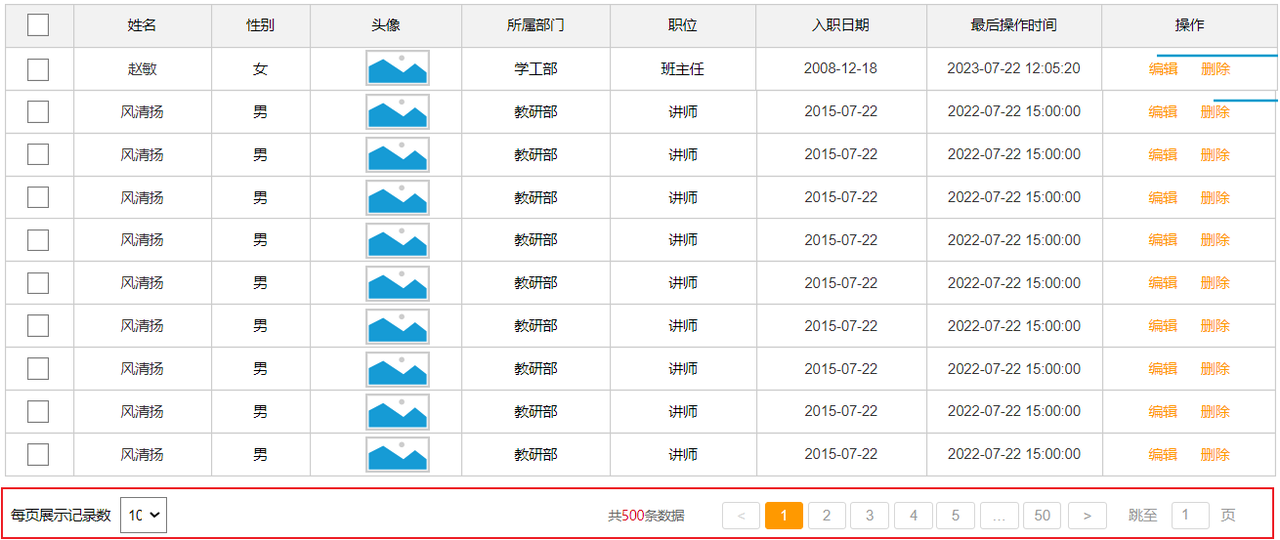
要想从数据库中进行分页查询,我们要使用LIMIT关键字,格式为:limit 开始索引 每页显示的条数。
1). 查询第1页数据的SQL语句是:
select * from emp limit 0,10;2). 查询第2页数据的SQL语句是:
select * from emp limit 10,10;3). 查询第3页的数据的SQL语句是:
select * from emp limit 20,10;观察以上SQL语句,发现: 开始索引一直在改变 , 每页显示条数是固定的
开始索引的计算公式: 开始索引 = (当前页码 - 1) * 每页显示条数
我们继续基于页面原型,继续分析,得出以下结论:
-
前端在请求服务端时,传递的参数
-
当前页码 page
-
每页显示条数 pageSize
-
-
后端需要响应什么数据给前端
-
所查询到的数据列表(存储到List 集合中)
-
总记录数
-
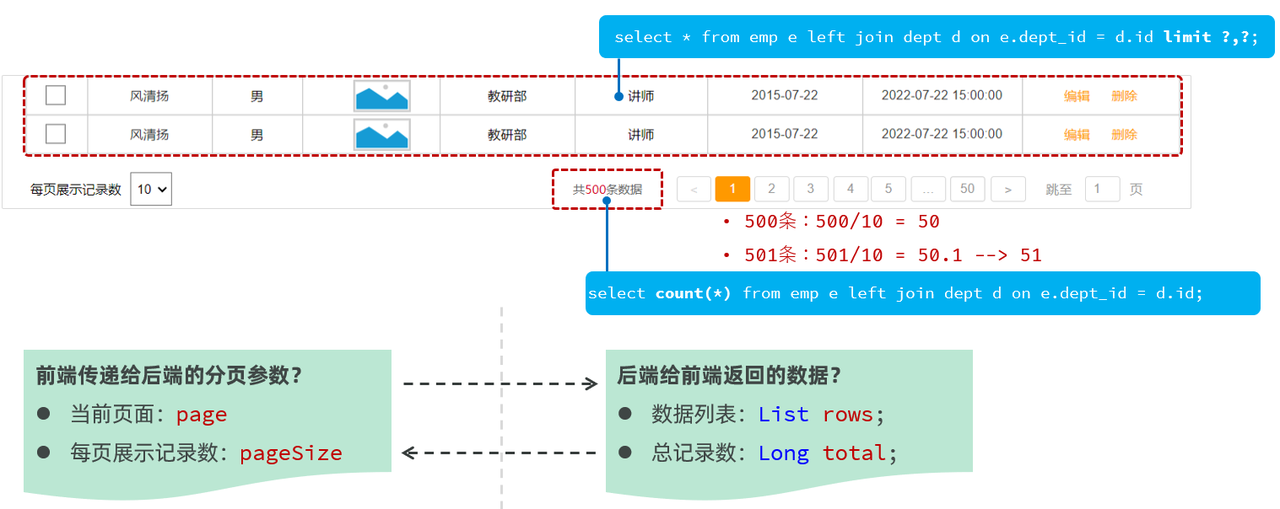
后台给前端返回的数据包含:List集合(数据列表)、total(总记录数)
而这两部分我们通常封装到PageResult对象中,并将该对象转换为json格式的数据响应回给浏览器。
@Data
@NoArgsConstructor
@AllArgsConstructor
public class PageResult {
private Long total; //总记录数
private List rows; //当前页数据列表
}接口描述
1). 基本信息
请求路径:/emps
请求方式:GET
接口描述:该接口用于员工列表数据的条件分页查询
2). 请求参数
| 参数名称 | 是否必须 | 示例 | 备注 |
| name | 否 | 张 | 姓名 |
| gender | 否 | 1 | 性别 , 1 男 , 2 女 |
| begin | 否 | 2010/1/1 | 范围匹配的开始时间(入职日期) |
| end | 否 | 2020/1/1 | 范围匹配的结束时间(入职日期) |
| page | 是 | 1 | 分页查询的页码,如果未指定,默认为1 |
| pageSize | 是 | 10 | 分页查询的每页记录数,如果未指定,默认为10 |
请求数据样例:
/emps?name=张&gender=1&begin=2007-09-01&end=2022-09-01&page=1&pageSize=103). 响应数据
参数格式:application/json
参数说明:
| 名称 | 类型 | 是否必须 | 备注 |
| code | number | 必须 | 响应码, 1 成功 , 0 失败 |
| msg | string | 非必须 | 提示信息 |
| data | object | 必须 | 返回的数据 |
| |- total | number | 必须 | 总记录数 |
| |- rows | object [] | 必须 | 数据列表 |
| |- id | number | 非必须 | id |
| |- username | string | 非必须 | 用户名 |
| |- name | string | 非必须 | 姓名 |
| |- password | string | 非必须 | 密码 |
| |- gender | number | 非必须 | 性别 , 1 男 ; 2 女 |
| |- image | string | 非必须 | 图像 |
| |- job | number | 非必须 | 职位, 说明: 1 班主任,2 讲师, 3 学工主管, 4 教研主管, 5 咨询师 |
| |- salary | number | 非必须 | 薪资 |
| |- entryDate | string | 非必须 | 入职日期 |
| |- deptId | number | 非必须 | 部门id |
| |- deptName | string | 非必须 | 部门名称 |
| |- createTime | string | 非必须 | 创建时间 |
| |- updateTime | string | 非必须 | 更新时间 |
响应数据样例:
{
"code": 1,
"msg": "success",
"data": {
"total": 2,
"rows": [
{
"id": 1,
"username": "jinyong",
"password": "123456",
"name": "金庸",
"gender": 1,
"image": "https://web-framework.oss-cn-hangzhou.aliyuncs.com/2022-09-02-00-27-53B.jpg",
"job": 2,
"salary": 8000,
"entryDate": "2015-01-01",
"deptId": 2,
"deptName": "教研部",
"createTime": "2022-09-01T23:06:30",
"updateTime": "2022-09-02T00:29:04"
},
{
"id": 2,
"username": "zhangwuji",
"password": "123456",
"name": "张无忌",
"gender": 1,
"image": "https://web-framework.oss-cn-hangzhou.aliyuncs.com/2022-09-02-00-27-53B.jpg",
"job": 2,
"salary": 6000,
"entryDate": "2015-01-01",
"deptId": 2,
"deptName": "教研部",
"createTime": "2022-09-01T23:06:30",
"updateTime": "2022-09-02T00:29:04"
}
]
}
}目前我们只考虑分页查询,先不考虑查询条件,而上述的接口文档中,与分页查询相关的参数就两个,一个是page,一个是pageSize。
原始方法
不多赘述
PageHelper分页插件
PageHelper是第三方提供的Mybatis框架中的一款功能强大、方便易用的分页插件,支持任何形式的单标、多表的分页查询。
官网:https://pagehelper.github.io/
那接下来,我们可以对比一下,使用PageHelper分页插件进行分页 与 原始方式进行分页代码实现的上的差别。

-
Mapper接口层:
-
原始的分页查询功能中,我们需要在Mapper接口中定义两条SQL语句。
-
PageHelper实现分页查询之后,只需要编写一条SQL语句,而且不需要考虑分页操作,就是一条正常的查询语句。
-
-
Service层:
-
需要根据页码、每页展示记录数,手动的计算起始索引。
-
无需手动计算起始索引,直接告诉PageHelper需要查询那一页的数据,每页展示多少条记录即可。
-
代码实现
当使用了PageHelper分页插件进行分页,就无需再Mapper中进行手动分页了。 在Mapper中我们只需要进行正常的列表查询即可。在Service层中,调用Mapper的方法之前设置分页参数,在调用Mapper方法执行查询之后,解析分页结果,并将结果封装到PageResult对象中返回。
1). 在pom.xml引入依赖
<!--分页插件PageHelper-->
<dependency>
<groupId>com.github.pagehelper</groupId>
<artifactId>pagehelper-spring-boot-starter</artifactId>
<version>1.4.7</version>
</dependency>2). EmpMapper
/**
* 查询所有的员工及其对应的部门名称
*/
@Select("select e.*, d.name deptName from emp as e left join dept as d on e.dept_id = d.id")
public List<Emp> list();3). EmpServiceImpl
@Override
public PageResult page(Integer page, Integer pageSize) {
//1. 设置分页参数
PageHelper.startPage(page,pageSize);
//2. 执行查询
List<Emp> empList = empMapper.list();
Page<Emp> p = (Page<Emp>) empList;
//3. 封装结果
return new PageResult(p.getTotal(), p.getResult());
}功能测试
功能开发完成后,我们重启项目工程,打开Apifox,发起GET请求,访问 :http://localhost:8080/emps?page=1&pageSize=5
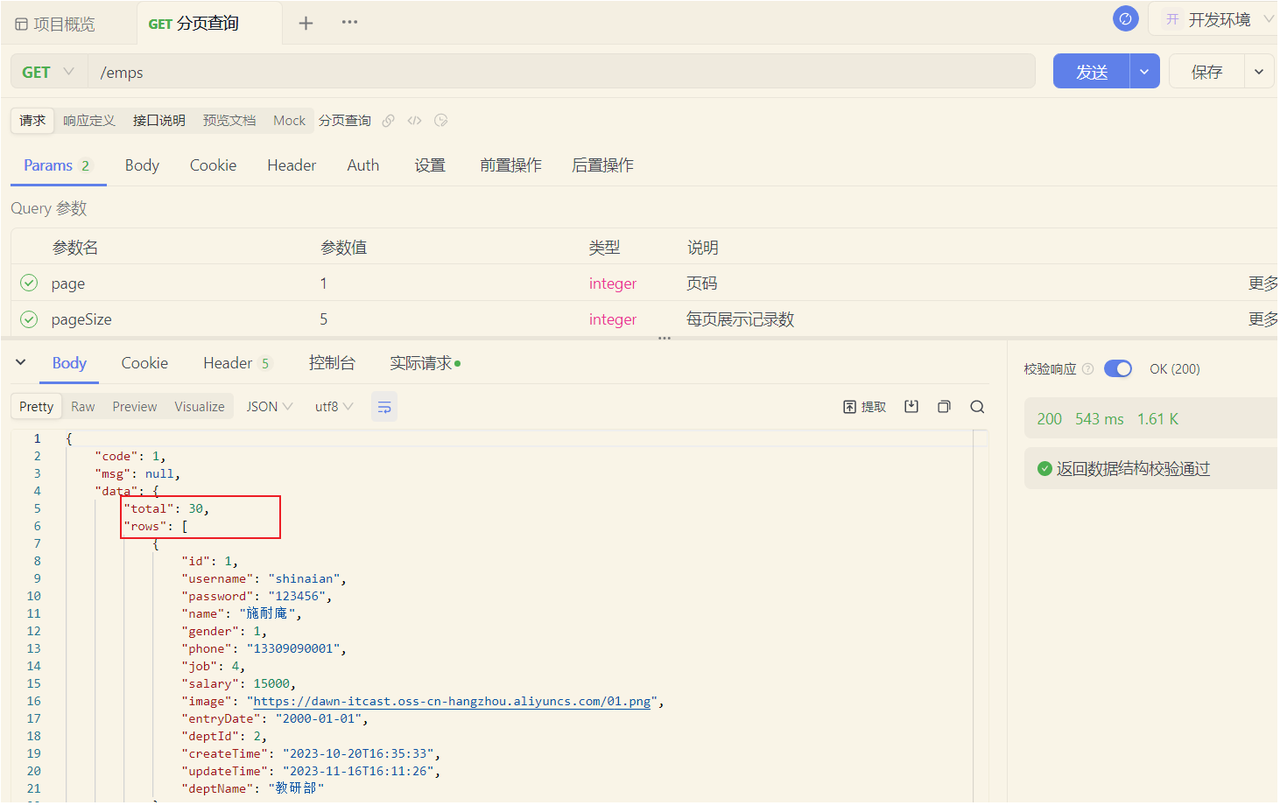
我们可以看到数据可以正常查询返回,是可以正常实现分页查询的。
实现机制
我们打开Idea的控制台,可以看到在进行分页查询时,输出的SQL语句。
 我们看到执行了两条SQL语句,而这两条SQL语句,其实是从我们在Mapper接口中定义的SQL演变而来的。
我们看到执行了两条SQL语句,而这两条SQL语句,其实是从我们在Mapper接口中定义的SQL演变而来的。
-
第一条SQL语句,用来查询总记录数。
 其实就是将我们编写的SQL语句进行的改造增强,将查询返回的字段列表替换成了
其实就是将我们编写的SQL语句进行的改造增强,将查询返回的字段列表替换成了 count(0) 来统计总记录数。
-
第二条SQL语句,用来进行分页查询,查询指定页码对应 的数据列表。
 其实就是将我们编写的SQL语句进行的改造增强,在SQL语句之后拼接上了limit进行分页查询,而由于测试时查询的是第一页,起始索引是0,所以简写为limit ?。
其实就是将我们编写的SQL语句进行的改造增强,在SQL语句之后拼接上了limit进行分页查询,而由于测试时查询的是第一页,起始索引是0,所以简写为limit ?。
而PageHelper在进行分页查询时,会执行上述两条SQL语句,并将查询到的总记录数,与数据列表封装到了 Page<Emp> 对象中,我们再获取查询结果时,只需要调用Page对象的方法就可以获取。
注意:
PageHelper实现分页查询时,SQL语句的结尾一定一定一定不要加分号(;).。
PageHelper只会对紧跟在其后的第一条SQL语句进行分页处理。
3.3条件分页查询
完了分页查询后,下面我们需要在分页查询的基础上,添加条件。
要求
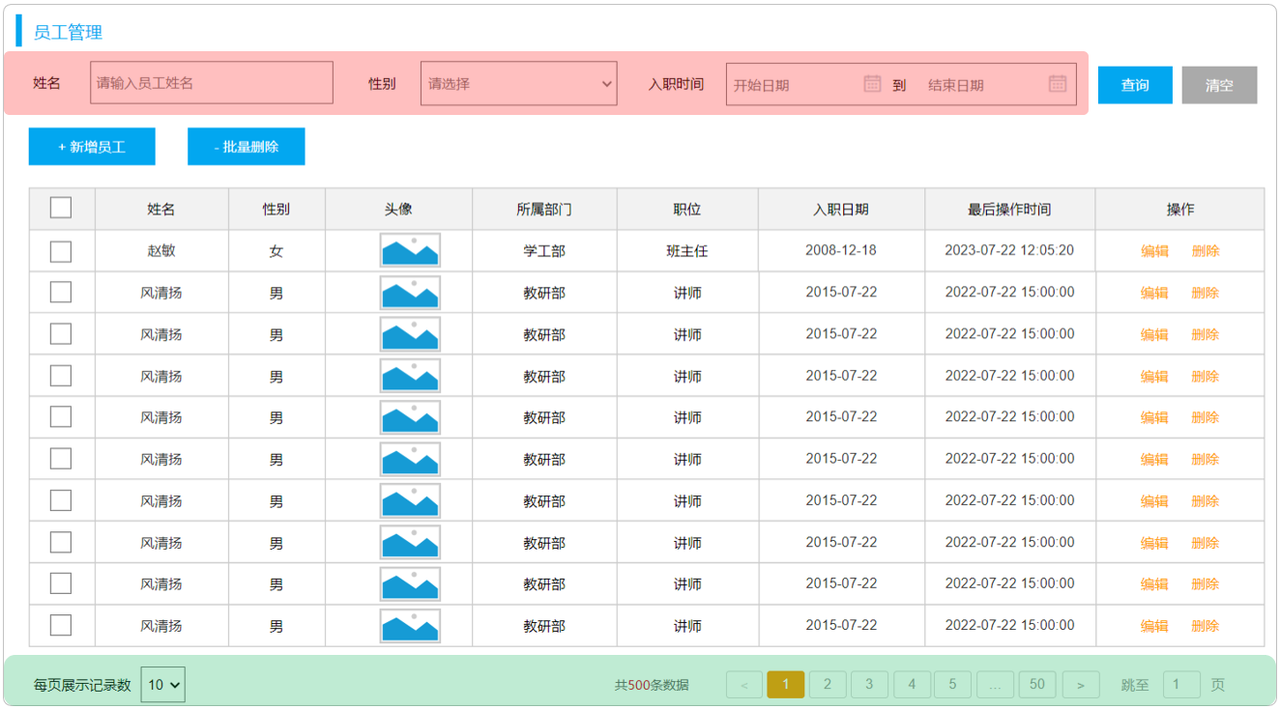
通过员工管理的页面原型我们可以看到,员工列表页面的查询,不仅仅需要考虑分页,还需要考虑查询条件。 分页查询我们已经实现了,接下来,我们需要考虑在分页查询的基础上,再加上查询条件。
我们看到页面原型及需求中描述,搜索栏的搜索条件有三个,分别是:
-
姓名:模糊匹配
-
性别:精确匹配
-
入职日期:范围匹配
思路分析

请求参数:
| 参数名称 | 是否必须 | 示例 | 备注 |
| name | 否 | 张 | 姓名 |
| gender | 否 | 1 | 性别 , 1 男 , 2 女 |
| begin | 否 | 2010/1/1 | 范围匹配的开始时间(入职日期) |
| end | 否 | 2020/1/1 | 范围匹配的结束时间(入职日期) |
| page | 是 | 1 | 分页查询的页码,如果未指定,默认为1 |
| pageSize | 是 | 10 | 分页查询的每页记录数,如果未指定,默认为10 |
在原有分页查询的代码基础上进行改造。
在上述分页条件查询中,请求参数比较多,有6个
那我们在controller层方法中,接收请求参数的时候,直接在controller方法中声明这样6个参数即可,这样做,功能可以实现,但是不方便维护和管理。
那么:我们可以定义一个实体类,来封装这几个请求参数【需要保证,前端传递的请求参数和实体类的属性名是一样的】
1). 定义实体类:EmpQueryParam
package com.itheima.pojo;
import lombok.Data;
import org.springframework.format.annotation.DateTimeFormat;
import java.time.LocalDate;
@Data
public class EmpQueryParam {
private Integer page = 1; //页码
private Integer pageSize = 10; //每页展示记录数
private String name; //姓名
private Integer gender; //性别
@DateTimeFormat(pattern = "yyyy-MM-dd")
private LocalDate begin; //入职开始时间
@DateTimeFormat(pattern = "yyyy-MM-dd")
private LocalDate end; //入职结束时间
}2). EmpController接收请求参数
@GetMapping
public Result page(EmpQueryParam empQueryParam) {
log.info("查询请求参数: {}", empQueryParam);
PageResult pageResult = empService.page(empQueryParam);
return Result.success(pageResult);
}3). 修改EmpService接口方法
public interface EmpService {
/**
* 分页查询
*/
//PageResult page(Integer page, Integer pageSize, String name, Integer gender, LocalDate begin, LocalDate end);
PageResult page(EmpQueryParam empQueryParam);
}4). 修改EmpServiceImpl中的page方法
@Service
public class EmpServiceImpl implements EmpService {
@Autowired
private EmpMapper empMapper;
/*@Override
public PageResult page(Integer page, Integer pageSize, String name, Integer gender, LocalDate begin, LocalDate end) {
//1. 设置PageHelper分页参数
PageHelper.startPage(page, pageSize);
//2. 执行查询
List<Emp> empList = empMapper.list(name, gender, begin, end);
//3. 封装分页结果
Page<Emp> p = (Page<Emp>) empList;
return new PageResult(p.getTotal(), p.getResult());
}*/
public PageResult page(EmpQueryParam empQueryParam) {
//1. 设置PageHelper分页参数
PageHelper.startPage(empQueryParam.getPage(), empQueryParam.getPageSize());
//2. 执行查询
List<Emp> empList = empMapper.list(empQueryParam);
//3. 封装分页结果
Page<Emp> p = (Page<Emp>)empList;
return new PageResult(p.getTotal(), p.getResult());
}
}5). 修改EmpMapper接口方法
@Mapper
public interface EmpMapper {
/**
* 查询所有的员工及其对应的部门名称
*/
// @Select("select e.*, d.name as deptName from emp e left join dept d on e.dept_id = d.id")
// public List<Emp> list(String name, Integer gender, LocalDate begin, LocalDate end);
/**
* 根据查询条件查询员工
*/
List<Emp> list(EmpQueryParam empQueryParam);
}6).Mapper映射文件EmpMapper.xml
<!--定义Mapper映射文件的约束和基本结构-->
<!DOCTYPE mapper
PUBLIC "-//mybatis.org//DTD Mapper 3.0//EN"
"http://mybatis.org/dtd/mybatis-3-mapper.dtd">
<mapper namespace="com.itheima.mapper.EmpMapper">
<select id="list" resultType="com.itheima.pojo.Emp">
select e.*, d.name deptName from emp as e left join dept as d on e.dept_id = d.id
where e.name like concat('%',#{name},'%')
and e.gender = #{gender}
and e.entry_date between #{begin} and #{end}
</select>
</mapper>重新启动测试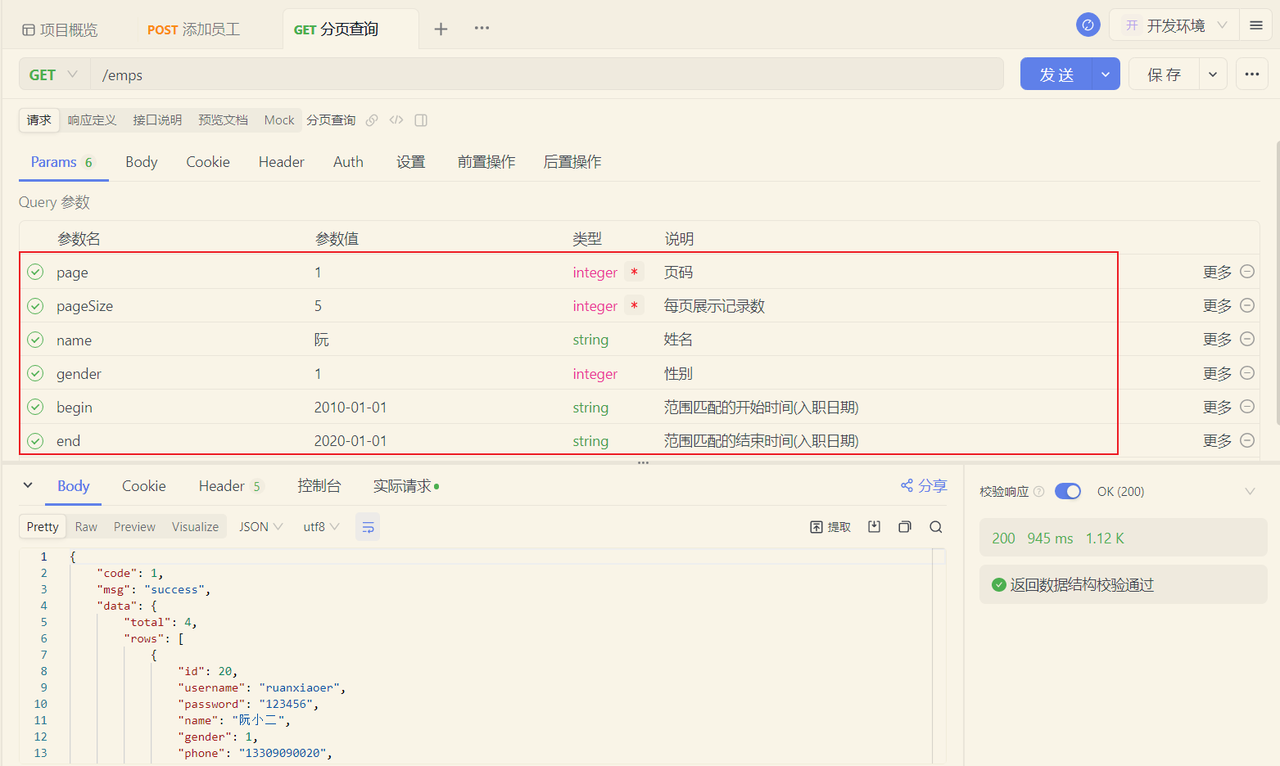
当我们在测试的时候,页码输入负数,查询是有问题的,查不到对应的数据了。
那其实在PageHelper中,我们可以通过合理化参数配置,来解决这个问题。直接在application.yml中,引入如下配置即可:
pagehelper:
reasonable: true
helper-dialect: mysqlreasonable:分页合理化参数,默认值为false。当该参数设置为true时,pageNum<=0时会查询第一页,pageNum>pages(超过总数时),会查询最后一页。默认false 时,直接根据参数进行查询。
测试如下:
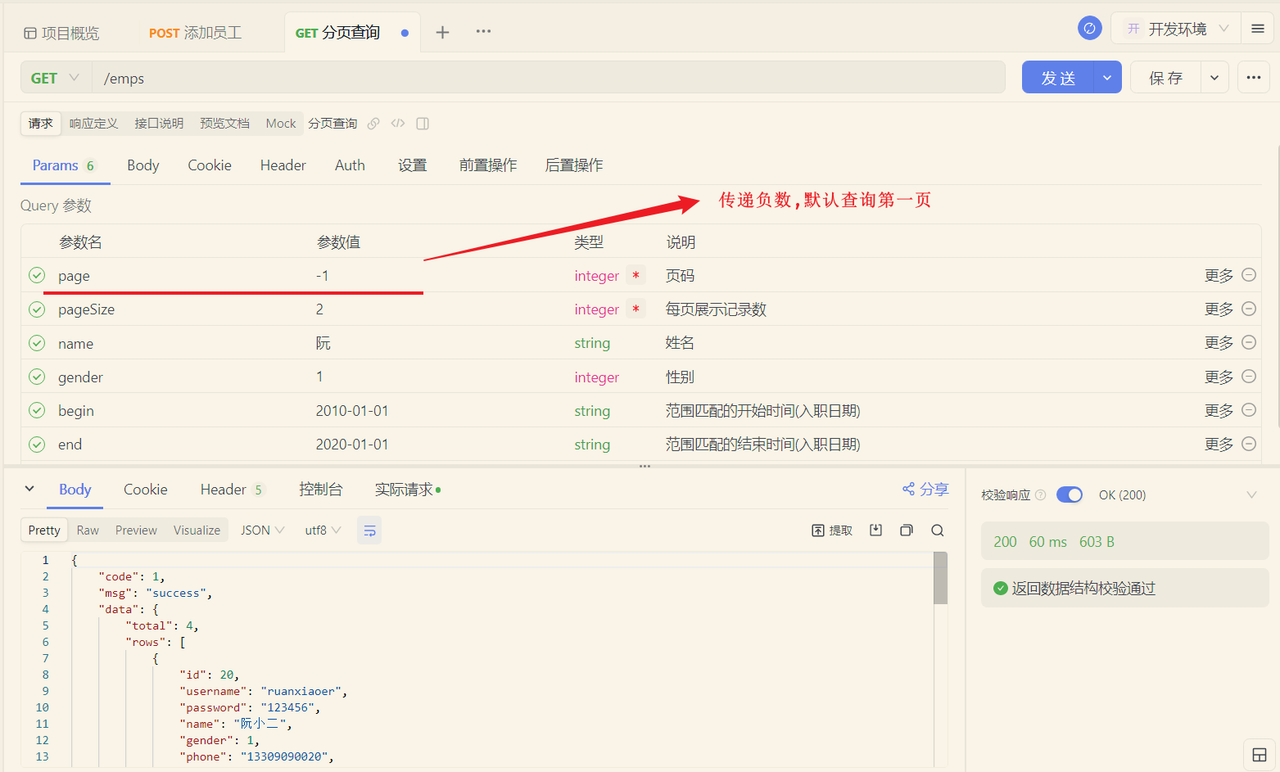
程序优化(动态SQL)
当前,我们在查询的时候,Mapper映射配置文件中的SQL语句中,查询条件是写死的。
而我们在员工管理实际情况中,根据条件查询员工信息时,查询条件是可选的,可以输入也可以不输入。

-
如果只输入 姓名 这个查询条件,则SQL语句中只根据name字段查询,SQL如下:
select e.*, d.name deptName from emp as e left join dept as d on e.dept_id = d.id where e.name like concat('%',#{name},'%');-
如果只输入 性别 这个查询条件,则SQL语句中只根据gender字段查询,SQL如下:
select e.*, d.name deptName from emp as e left join dept as d on e.dept_id = d.id where e.gender = #{gender};-
如果输入 姓名 和 性别 这两个查询条件,则SQL语句中要根据name、gender两个字段查询,SQL如下:
select e.*, d.name deptName from emp as e left join dept as d on e.dept_id = d.id
where e.name like concat('%',#{name},'%') and e.gender = #{gender};我们看到,这个SQL语句不应该是写死的,而应该根据用户输入的条件的变化而变化。 那这里呢,就要通过Mybatis中的动态SQL来实现。
所谓动态SQL,指的就是随着用户的输入或外部的条件的变化而变化的SQL语句。
具体的代码实现如下:
<!--定义Mapper映射文件的约束和基本结构-->
<!DOCTYPE mapper
PUBLIC "-//mybatis.org//DTD Mapper 3.0//EN"
"http://mybatis.org/dtd/mybatis-3-mapper.dtd">
<mapper namespace="com.itheima.mapper.EmpMapper">
<select id="list" resultType="com.itheima.pojo.Emp">
select e.*, d.name deptName from emp as e left join dept as d on e.dept_id = d.id
<where>
<if test="name != null and name != ''">
e.name like concat('%',#{name},'%')
</if>
<if test="gender != null">
and e.gender = #{gender}
</if>
<if test="begin != null and end != null">
and e.entry_date between #{begin} and #{end}
</if>
</where>
</select>
</mapper>在这里呢,我们用到了两个动态SQL的标签:<if> <where>。 这两个标签的具体作用如下:
<if>:判断条件是否成立,如果条件为true,则拼接SQL。
<where>:根据查询条件,来生成where关键字,并会自动去除条件前面多余的and或or。
代码优化完毕后,重新启动服务
没有输入任何查询条件时,运行日志如下:
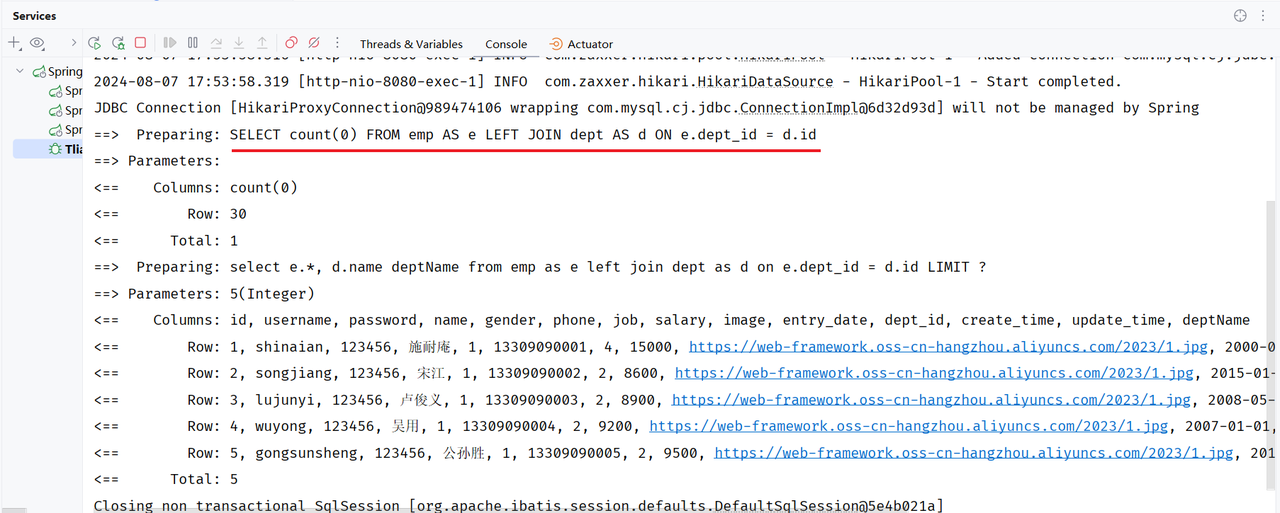
当我们输入姓名和性别时
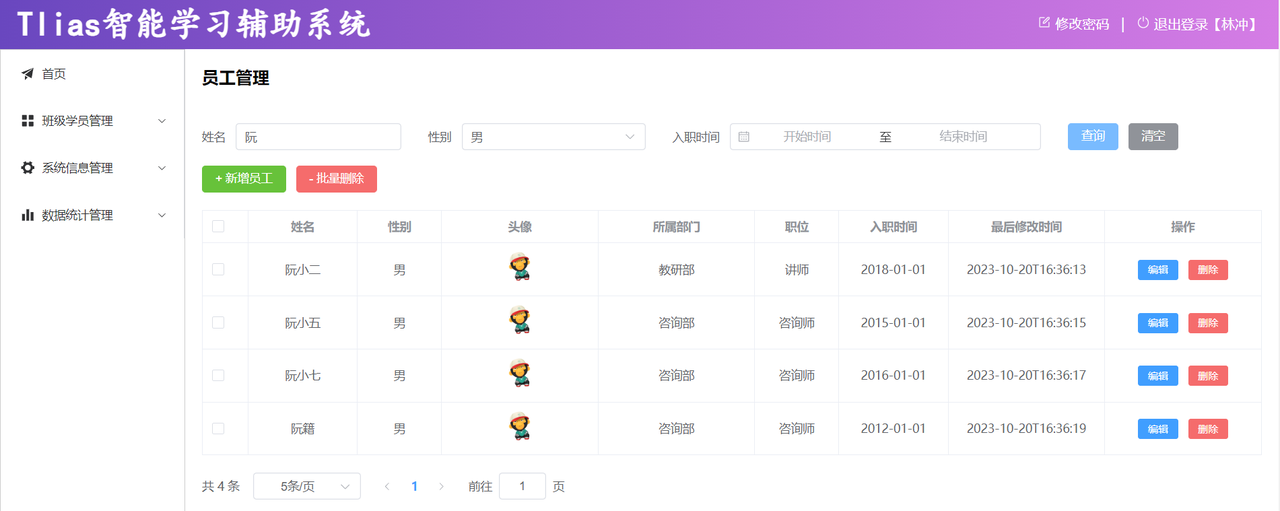
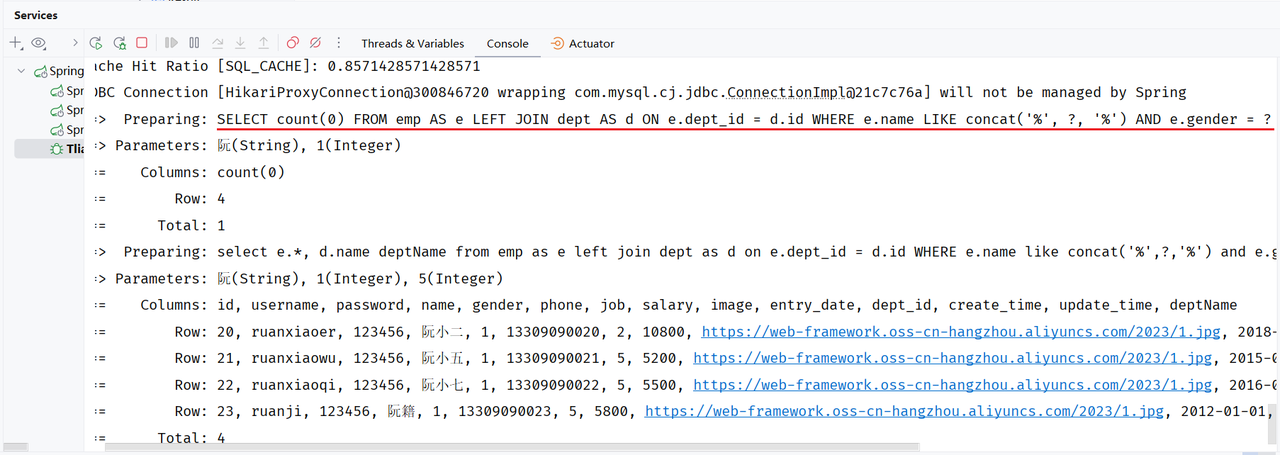
我们可以看到,当我们输入不同的搜索条件时,会动态的根据查询条件,动态拼接SQL语句。
更多推荐
 已为社区贡献1条内容
已为社区贡献1条内容







所有评论(0)